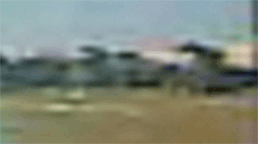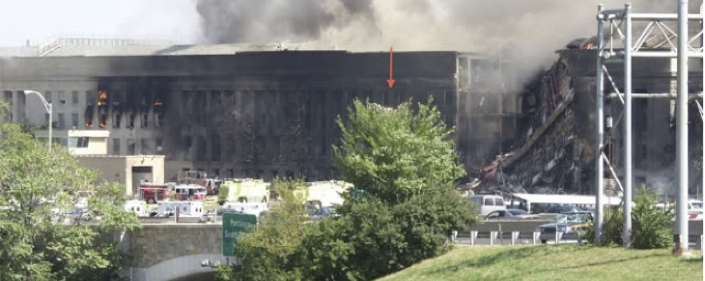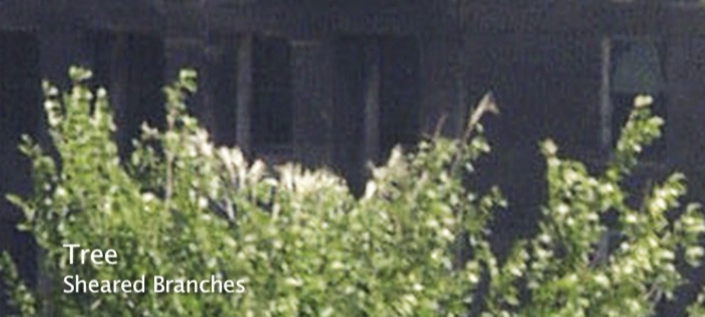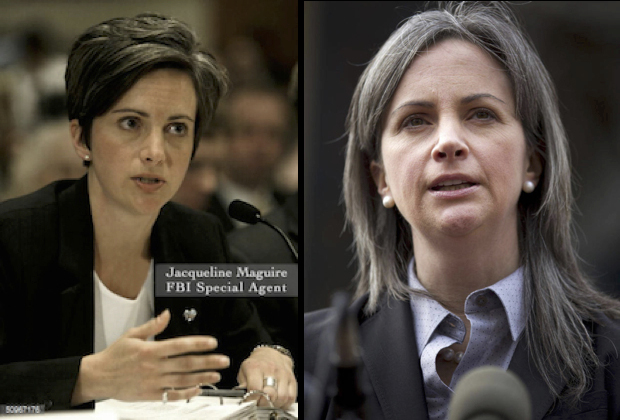The Pentagon Area Surveillance Camera Videos
By Ken Jenkins

Introduction
According to the FBI, there were about 80 video camera surveillance recordings, many of which were recorded in the vicinity of the Pentagon, that might have captured some parts of the Pentagon event on 9/11/01. The FBI confiscated some of those recordings from those cameras within hours the 9/11 event, and the rest over the following days. This act of confiscation by the government fueled the suspicions of those questioning a large plane impact into the Pentagon.
It is known that the FBI confiscated much 9/11 evidence, including evidence at all four crash sites; thus their confiscations at the Pentagon were typical, not unusual. However, since the two videos recorded at the Pentagon that were released do appear to contain useful information about what hit the Pentagon, we should not automatically assume the FBI is being dishonest or evasive in this case.
Why very few cameras captured the impact event
There are a number of valid reasons why only four of the 80 video recordings that were released by the FBI in response to a FOIA (Freedom Of Information Act) request filed in 2004, which was fulfilled in 2006 had any relevant evidence. Because of a number of factors (listed below and detailed in the footnotes) only four of the 80 video recordings captured any useful footage of the plane-impact event, and only two of those four showed any direct visual evidence [1]. The other two recordings revealed only indirect evidence, including a shadow on the ground in one video frame which appears to be from the plane flying overhead.
- Most of the video cameras were not aimed in the direction of the Pentagon and/or at the part of the Pentagon in question – the impact zone.
- Most cameras and recorders were located a considerable distance from the impact event, and virtually all surveillance cameras had wide-angle (fisheye) lenses which render distant objects at very low resolution, and which cause some geometric distortion to the image.
- Many cameras had obstructed views of the Pentagon impact area.
- In 2001, virtually all surveillance cameras rendered low spacial resolution images of at best 480i, and more often less. 480i is what is now called SD – Standard Definition.
- In 2001, most surveillance cameras recorded video at low frame rates (low temporal resolution), often in the range of 1 to 8 frames per second. By comparison, US TV is most often recorded at 30 frames/second.
- The high speed of the plane, which was accelerating to over 550 mph, resulted in image blurring in the video recording, and offered a low chance of catching more than a single frame of the plane, given the low-recorded frame rate (low temporal resolution) of 1 frame/second).
History
The so-called “5-frames” from one of the two Pentagon surveillance cameras were first released in March of 2002. The only frame that appears to include the plane has a post in the foreground obstructing the camera’s view of most of the plane except for the tip of the nose and the tail fin. It also shows a trail of white smoke which appears to be coming from the rear of the plane.
In December 2004, Judicial Watch, a public interest group, filed a FOIA request on behalf of Scott Bingham. The request was for surveillance camera footage that might show the plane approaching and/or hitting the Pentagon.
The FBI identified 85 surveillance camera recordings that were located in the general vicinity of the Pentagon that might have revealed the plane. After the Zacarias Moussaoui trial ended in 2006, the Department of Defense released 4 of those videos, including a 200 frame extended version of the 5-frame sequence first released in 2002.
Completely new to the public in 2006 were the 183 frames that were released from a second identical surveillance camera located adjacent to the first camera within the same security checkpoint. One of these new frames provided an unobstructed view of the plane, but at such low contrast and resolution it was not initially noticed or reported as such. Instead, what appears to be the same white smoke seen in the crucial frame from the first camera (released in 2002) is also seen at the edge of the second camera’s crucial frame. The shape of the white smoke was mistakenly identified in news media as the plane’s nose.3
What the two Pentagon surveillance camera recordings reveal
Both of the two Pentagon surveillance cameras were in a security check point located about 833 feet north of the impact point. Both cameras show what appears to be white smoke trailing the approach of a rapidly moving object. The frames that followed the impact of that object show a massive orange fireball, quickly followed by a rising column of black smoke, and then debris fragments raining down and landing near the two cameras six to nine seconds after the impact.4
The second Pentagon camera had an unobstructed view, and has one frame which appears to show a plane near the right edge of the frame, and appears to have the same white smoke trail that is seen in the 5-frame sequence. In a way similar to the identical first (5-frames) camera, the recordings from this second camera yielded a low resolution image of distant objects due in part to their wide-angle lenses, so the images do not make clear what is revealed by the second camera’s frames either. But what does appear in the crucial frame from the second camera resembles an out-of-focus airliner, including the tail fin and trailing smoke as seen in the adjacent “5-frame” surveillance camera.

A blowup of a close-up part of two frames from the second Pentagon surveillance camera.
As seen in the frames from both cameras and as noted here, there was a large fireball explosion seen in several frames, as would be produced by atomized jet fuel. This fireball closely resembled the two jet fuel fireballs seen at the Twin Towers of the WTC.

WTC 2 Pentagon WTC 2
The preponderance of eyewitness and physical evidence points to a plane, specifically a silver plane, which produced that fireball seen in footage from both cameras, and seen by hundreds of witnesses.
One of the first of the five frames shows a fuzzy dark shape resembling a plane tail fin projecting upwards above and behind the top of a post in the foreground that obscures most of the approaching plane.

Frame from the first Pentagon surveillance camera (detail)
In the next frame, the fuzzy tail fin is gone, and a fireball is seen erupting from the side of the Pentagon building.
A computer graphic simulation by Mike Wilson,5 illustrating a 757-sized plane impact approaching and impacting the Pentagon, incorporates the one crucial frame of the 5-frame sequence and clearly illustrates how a 757 would be almost completely obscured by the post, except for the tail and a bit of the nose.

Computer graphic simulation of a frame from the first camera
A few researchers have questioned the five frames as doctored, staged and/or fraudulent, but there is no evidence for such fraud.
Further analysis of the frames from the two on-site surveillance cameras, and in particular of their common multiplexer and recorder system, may eventually provide additional evidence.
Why was the plane trailing white smoke?
The trailing white smoke was generated by burning tree branches and leaves ingested by the right engine of Flight 77. This tree appears in the two images below.


The top of a tree with sheared branches was aligned with the right engine of the 757.
Conclusion
Since 2006, researchers have had all the frames of interest from both of the two Pentagon surveillance cameras with the best useful information about the Pentagon plane event. Two other surveillance cameras, located some distance from the Pentagon, also provided useful images, in the form of indirect evidence of the plane.
Unfortunately, all the surveillance camera images are low resolution, and so what is seen is inconclusive. But what can be concluded with confidence is that the footage from all four cameras is consistent with the large plane impact theory. Perhaps most significantly, one camera seems to show an unobstructed, but low-resolution view of the rapidly approaching plane. [2]
Acknowledgments
This paper was adapted and expanded from a section of a new paper by Victoria Ashley, David Chandler, Jonathan H. Cole, Jim Hoffman, Ken Jenkins, Frank Legge, and John D. Wyndham published here: Scientific Method 9/11. Additional editing assistance by Paul Rea. Thank you all for your help.
Footnotes
[1] FBI Special Agent Jacqueline Maguire was tasked with responding to the 2004 Judicial Watch FIOA request, made on behalf of Scott Bingham, regarding the surveillance camera recordings the FBI gathered in the Pentagon area after 9/11.

Ms. Maguire’s specific responses are in quotes in the following text.
The FBI said they identified 85 video recordings that might show the plane impact into the Pentagon, but this number was the result of an initial search that included (for example) all videos obtained by the Washington Field Office.
From that 85 recordings starting number, the number of useful recordings regarding the Pentagon event begin to fall dramatically:
- Very nearly 2/3rds of the 85 recordings, specifically 56 “of these video recordings did not show either the Pentagon building, the Pentagon crash site, or the impact of Flight 77 into the Pentagon on September 11.” That left 29 video recordings remaining.
- Of the 29 video recordings remaining, 16 did show some part of the Pentagon, but “did not show the Pentagon crash site and did not show the impact of Flight 77 into the Pentagon.” That left 13 video recordings remaining.
- The 13 recordings remaining, nine “only showed the Pentagon after the impact of Flight 77.” An example is one of the two B/W video recordings that were released from the nearby Doubletree Hotel. That camera was initially pointed away from the Pentagon, then re-positioned minutes after the crash to point towards the smoke cloud rising from the Pentagon crash site. That left four video recordings remaining.
- Of the four recordings remaining, two did not directly show the approaching plane. One, a B/W recording from the CitGo gas station shows one frame with the shadow of the plane on the ground from the plane flying overhead, out of view of the camera. A second B/W recording from the Doubletree Hotel shows the rising fireball and black smoke post-impact, but does not show the approaching plane due to obstructing highway structures. That left two video recordings remaining.
- Of the two recordings remaining, both were from the Pentagon’s two color security gate cameras, and both clearly showed the Pentagon impact fireball in multiple frames. One of those two recordings seems to show only the rear fin of the plane, due to a foreground post obstructing a critical part of the view of that camera. It also shows a cloud of wavy white smoke trailing the plane. The other recording seems to show the entire plane unobstructed, as well as part of the same trailing white smoke cloud. This second recording with the unobstructed view is featured in David Chandler’s video titled Seeing the Pentagon Plane [2].
[2] Seeing the Pentagon Plane – video by David Chandler http://911speakout.org/seeing-the-pentagon-plane
[3] May 16, 2006, CNN – Anderson Cooper “Keeping Them Honest”
[4] http://911research.wtc7.net/pentagon/evidence/videos/dodvideos.html
[5] Integrated Consultants, Inc., http://www.youtube.com/watch?v=YVDdjLQkUV8
Additional links
http://web.archive.org/web/20080208102217/http://www.flight77.info/85videos.html
9/11 Pentagon Attack Footage Flight 77, 2012, analysis of the 2nd camera .https://www.youtube.com/watch?v=0f6t4dMtc00&feature=youtu.be
Addendum
Date/Time overlay from 5-frames released in March 2002
The 5-frame sequence as released in 2002 had a date/time stamp added, with the date 9/12/2001, along with the word “plane” in the first frame, and “impact” in the second and following frames (the frames with the fireball).

Some have thought that the added date being off by a day and the wrong time was suspicious and might reveal fraud, but the 2006 release of 200 frames without the date/time stamps revealed that the date/time overlays in the frames released in 2002 were not added in real time or burned into the video, but were added later, specifically on September 12, 2001 when those frames were first downloaded from the original recording.
We now have confirmation that the date/time and descriptive text were added the following day, on 9/12/2001. We know this from a November 9, 2006 interview with Brian Austin and Steve Pennington, who both worked installing and testing the Pentagon surveillance cameras. Pennington extracted those frames on 9/12/2001 as requested by FBI officials. Pennington added the descriptions “plane” and “impact”. Pennington said:
“Unfortunately, the software had a bug in it, and when a still image was saved, it captured the time in the computer at the time you were capturing the image or saving the image from the video to become a still picture…. That [bug] has long since been corrected, but that is the reason that the time and date are wrong.”
This detailed interview informs us about much more than the source of the date error. For example, the interview describes the purpose of the two surveillance cameras in question, and why they were aimed as they were.
There is also mention of why there were not images from other cameras at the Pentagon. For example, several cameras were destroyed by the plane impact. Besides other cameras, they discuss the digital recorder, what CD-ROM copies were made and for who, the recording frame rate and why it was so slow (1 fps), the backup recordings made onto DAT media, and other details.
This interview helps confirm the legitimacy of the recordings of the two Pentagon surveillance cameras, and of the frames from them that were leaked in 2002, and later formally released in 2006. It follows the chain of custody of the evidence from the FBI, who released the frames to the public, back to the actual two people who pulled those frames off the recorder that contained the desired image data from the recordings of both cameras – including frames of the plane and of the jet fuel fireball that resulted from plane’s impact into the side of the Pentagon.
Thus there is little reason to doubt the legitimacy of the surveillance camera frames that shows the blurry plane rapidly approaching the Pentagon a fraction of a second before impact.
The full interview with Brian Austin and Steve Pennington can be found here: http://history.defense.gov/Portals/70/Documents/oral_history/OH_Trans_AustinBrian%20Steve%20Pennington111-9-2006.pdf
